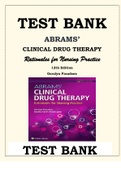Exam (elaborations)
ABRAMS' CLINICAL DRUG THERAPY: RATIONALES FOR NURSING PRACTICE 12TH EDITION TEST BANK Test Bank Abrams' Clinical Drug Therapy Rationales for Nursing Practice 12th Edition By Geralyn Frandsen, Sandra S. Pennington ISBN- 978-1975136130 ISBN:
- Course
- Institution
- Book
ABRAMS' CLINICAL DRUG THERAPY: RATIONALES FOR NURSING PRACTICE 12TH EDITION TEST BANK Test Bank Abrams' Clinical Drug Therapy Rationales for Nursing Practice 12th Edition By Geralyn Frandsen, Sandra S. Pennington ISBN- 978-0 ISBN: 6154 This is a Test Bank Consists of Study Questions and solution...
[Show more]



